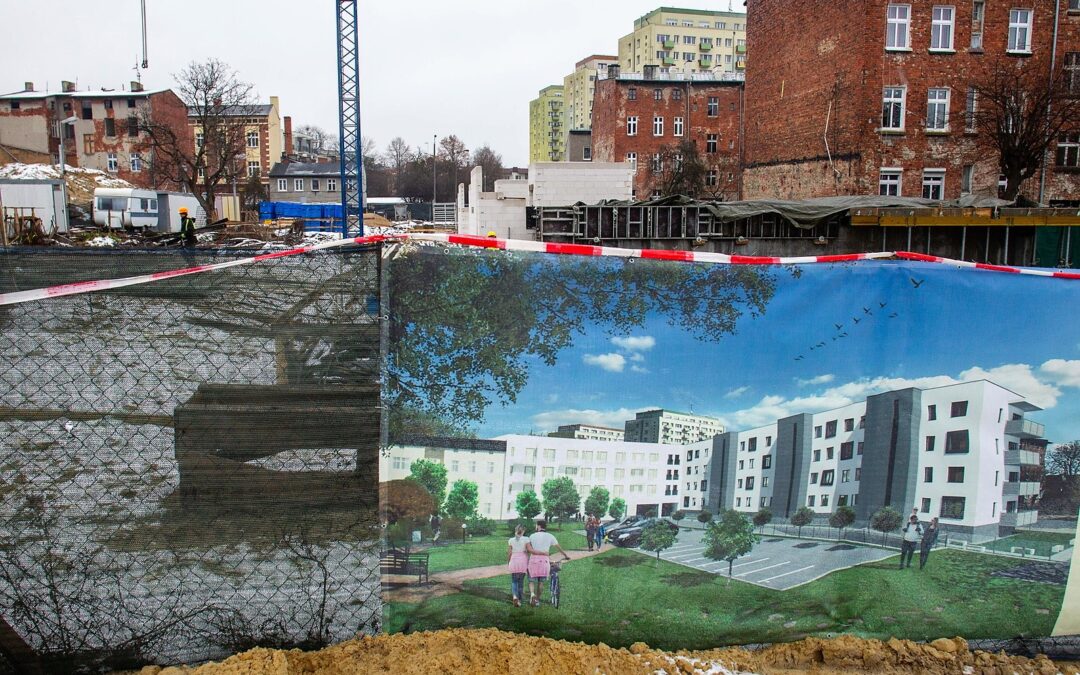By Anna Rzhevkina
When the pandemic began, many believed it would reverse Poland’s rapid rise in house prices. Instead, they have continued to grow at one of the fastest rates in the EU, and now often rival those found in western Europe. The government’s new economic programme, which seeks to help families buy property, could further stoke the market.
“Apartments for investment,” reads the block-caps advertisement on the front of the Dom&House real estate agency in central Gdańsk, on Poland’s northern Baltic coast. Next to it there are photos of cosy two-room apartments on the Motława river, selling at a hefty one million zloty (€220,000) each.
Such prices, once difficult to imagine, have become the standard fee for a modern pad in Polish cities – and are often equivalent to those found in western Europe.
In Warsaw, the capital, the average price per square metre of an apartment in the city centre is now 17,881 zloty (€ 3,957), more expensive than in Brussels (€3,660) or Bologna (€3,856), according to Numbeo, a site comparing global costs of living.
Despite the economic slowdown caused by the pandemic, real estate prices have continued to grow, albeit at a slightly slower pace. Mortgage availability, combined with high inflation and low interest rates, have made real estate an attractive way to invest money amid a lack of alternatives.
The average offer price in the secondary market in seven large cities tracked by Poland’s central bank – Warsaw, Gdańsk, Gdynia, Kraków, Łódź, Poznań, and Wrocław – rose to 9,849 zloty (€2,180) per square metre at the end of the first quarter of 2021, compared with 9,473 (€2,100) zloty last year. The growth rate has slowed from 11% in the previous year to 4% now.
In the primary real estate market, consisting of new properties, prices are growing faster still. In May, the average apartment prices per square metre rose across cities by more than 7% year-on-year, data from real estate service Otodom.pl showed. Small towns and cities with a population above 200,000 people recorded double-digit growth.
Demand remains high among both investors and prospective homeowners. “Some buyers treat apartments as a safe place for their savings. Others take advantage of the fact that home loans are cheaper than ever and the banks do not apply excessive restrictions,” says Marek Wielgo, an analyst at real estate company Gethome.pl.
Putting money into real estate yields accrues better interest than traditional savings accounts. Poland’s central bank has kept its key interest rate unchanged at a record low of 0.1% since last May, in an effort to bolster post-pandemic economic growth.
This has pulled down the average interest rate on deposits to just 0.34% net, while an average investment in an apartment for rent gives a nine-times higher return if it is occupied for 10 months of the year, e-commerce company Expander calculates.
According to Kazimierz Kirejczyk, vice president of the management board at property consultancy company JLL, another strong incentive for people to withdraw savings from banks is a concern for their security.
“If the money invested in a flat or house purchased from a developer is to be safer than a deposit in a bank (after all, it is only guaranteed up to 100,000 euros, which is lower than today’s price of an average new flat in Warsaw), this will be a strong incentive for people to withdraw their savings from the banking system,” he said in a company report.
Buyers have been snapping up new apartments faster than developers can deliver them to the market. As a result, the supply has been drying up and pushing prices up further. This has lured investors, who buy to make profit, Wielgo adds.
As a result, in the third quarter of 2020 house prices in Poland had grown faster (by 10.9%) over the previous 12 months than in any European Union member state other than Luxembourg (13.6%), according to Eurostat data.
Renting versus buying
Last year’s pandemic lockdown spurred many students and workers to abandon their rented stays and move back to their family home for remote work. One of them was Dorota Martyniuk, a 30-year-old data analyst from Wrocław, who before the pandemic rented a room for about 1,000 zloty (€220) per month in the seaside town of Sopot.
“My contract in Sopot was over in June. I had to move out, and I was not sure whether I should stay there or go back to Wrocław,” she says. “Everything was closed. I didn’t like paying for a room just to stay in. And I decided to go to my parents’ place in Wrocław.”
This has pulled down rental prices. In Warsaw, Kraków, and Gdańsk these declined by between 9.1 and 9.5% per square metre from February 2020 to this year. Growth was recorded only in two cities: Toruń (by 3.3%) and Łódź (2.2%).
The rental market has also become more sluggish. Apartments now stand empty for an average of two months between tenants. Despite this, owners can still make a net return of over 1% renting one out for only six months a year, which is approximately three times higher than the interest on a bank deposit.
Poland is still an attractive market for real estate companies that invest in properties for rent. At the end of May, Swedish company Heimstaden Bostad struck a 1.4 billion zloty (€310 million) deal to buy 2,500 apartments from real estate developer Budimex in five major Polish cities. For the company, which only entered the Polish market last December, this is already its third acquisition.
Before the pandemic, the popularity of apartments for rent had been growing rapidly, as increasing numbers of people no longer wanted to tether themselves to a single location with a long-term loan. Demand is also driven by foreigners who come to Poland to study and work. Yet renting was expensive, costing on average 9% more than a loan instalment.
What has put off some families off buying, however, has been the 10% one-off payment requirement to secure a mortgage. Now, though, the government is seeking to change that.
The Polish housing deal
In mid-May, Poland’s government unveiled a plan to bolster the economy in its recovery from the pandemic, including with support for house buyers, pensioners and families, as well as tax cuts for low- and middle-earners.
Under the so-called “Polish Deal” (Polski Ład), the government plans to boost homeownership by helping people secure and pay off mortgages. Moreover, permits will no longer be required for the construction of single-family houses up to 70 square metres.
The government will guarantee home loans of up to 100,000 zloty (€22,100) for borrowers aged between 20 and 40. The government will also help with the repayment of mortgages after the birth of second or subsequent children. Families with many children, or those who buy social housing, may get subsidies of up to 160,000 zloty (€35,400).
The government has unveiled its "Polish Deal" (#PolskiŁad) plan for recovery from the pandemic.
With increased support for parents and homebuyers, plus an overhaul of the tax system, it will "build a middle class for all, not for the few", claims the PM https://t.co/X2GpjnGdgb
— Notes from Poland 🇵🇱 (@notesfrompoland) May 16, 2021
“A guaranteed own contribution may lead to a further increase in real estate prices, which in turn may cause a crash similar to the one that occurred less than 20 years ago in the USA,” warns Jarosław Krawczyk from Otodom.pl.
High inflation encourages people to invest in real estate. However, when interest rates eventually increase, some borrowers may struggle with loan repayment, Krawczyk adds.
Moreover, in a worst-case scenario, banks may eventually turn off the tap on mortgages to avoid growing numbers of problem loans, thus making housing less accessible, contrary to the initial goals set by the government.
Wielgo of Gethome.pl agrees. When people apply for a loan without their own contribution, they are likely to opt for more expensive property, he tells Notes from Poland. “The effects of the economic downturn and an increase in interest rates will be painfully felt by many recipients of government loan guarantees,” adds the analyst.
As domestic real estate is snatched up, more Poles seek property abroad
Greater acceptance of remote work may be one of the lingering effects of the pandemic, further increasing demand among Poles for foreign properties.
“If they can choose, they opt for warmer countries with good cuisine, where the pace of life is slower than in northern Europe,” Bartłomiej Annusewicz, CEO of Lions Estate, told Gazeta Wyborcza. One increasingly popular location is Spain – the only country in the EU where real estate prices declined at the end of last year.
When the pandemic started, there were concerns that a reeling economy would drag real estate prices down. However, the reality turned out to be the opposite. Developers have rushed to meet booming demand and Poles have hurried to invest.
The estate agents in Gdańsk will not have to wait long for their new riverside apartments to be snatched up.
Main image credit: Roman Bosiacki / Agencja Gazeta




















